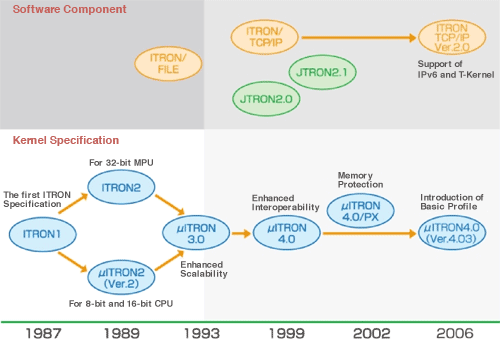What is ITRON?
Since its inception in 1984, TRON Project has studied and released OS specifications that fit the application fields. Kernel specification has been established and released as real-time OS for embedded devices based on ITRON specification. This specification has been revised as required from time to time based on technology trend and marketing needs. TRON Project has placed the utmost importance on the standardization of kernel specifications because small-scale embedded systems often use just the kernel functions.
The first ITRON specification was developed in 1987 as ITRON1 specification. Some real-time kernels were developed based on the ITRON1 specification and applied, and played a great role in or verifying the specification’s usability. Later, in 1989, TRON Project released two specifications: the μITRON Specification (Ver. 2.0) and the ITRON2 specification. The μITRON specification defined a limited kernel for small systems with 8 or 16-bit MCUs. The ITRON2 specification, on the other hand, was designed for large systems with 32-bit MCUs. Kernels based on the μITRON specifications have been implemented on many different MCUs with extremely limited memory and limited computational resources because they offered a reasonable performance on such MCUs. They have been used on a wide variety of embedded systems. Actually, it would not be an exaggeration to say that μITRON specification OS has been developed on almost all the main MCUs for embedded systems.
As the μITRON specifications were applied to a wide range of application fields, necessary functions and request for performance were understood better. Even though the μITRON Specifications were not designed for 32-bit processors, as the application field of MCU got wider, kernels based on the μITRON-specification were now being implemented on 32-bit MCUs. Based on these observations, a new specification was written to be scalable on MCUs ranging from 8 bits to 32 bits. The result was the μITRON3.0 Specification released in 1993.
The μITRON specification emphasized the adaptation to hardware and processor more than the software portability, and adopted the policy of “weak standardization” that reduced execution overhead and memory usage for each implementation. Thanks to the “weak standardization” policy, μITRON specification could realize the scalability that supported wide-ranging processors from 8 to 32 bits. However, software portability didn’t go along well with scalability in many ways, and it was difficult to realize both features with one specification. Consequently, the μITRON4.0 specification released in 1999 made it possible to realize the high portability of software while maintaining the “weak standardization” policy by adopting the framework of using sets of standard functions called “standard profiles” and defining these profiles rigorously.
In 2002, T-Engine Project started and the target of the standardization activities for the advanced next-generation real-time OS moved to the T-Kernel family. With this shift, the needs for smooth transition from μITRON to T-Kernel arose. In response to the needs, the μITRON4.0 specification Ver.4.03 released in 2006 defined the “basic profile” that lists the service calls that can be used equivalently in μITRON3.0, μITRON4.0, and T-Kernel. The porting of the middleware and the applications from μITRON to T-Kernel is relatively easy as long as they run using functions within the profile.
At present, there are 37 real-time kernel products based on the ITRON specifications for approximately 60 processors as far as TRON Forum is aware. There is also a software vendor in the United States that has developed an ITRON-specification kernel and marketed it. Since a kernel based on μITRON-specification is small and is relatively easy to implement, many users have developed their own versions for in-house use. There are also many implementations besides marketed products, and some kernels based on the μITRON-specifications are distributed as free software.
The reason why kernels based on the ITRON-specifications are used in so many instances is because they support a wide range of applications and have many prior adaptation examples. Table 1-1 shows examples of some appliances that use ITRON-specification kernels. From the survey conducted in the past by TRON ASSOCIATION (conducted by TRON Forum from 2010), the ITRON specification OSs are used widely in consumer products and they have become the de facto standard in the industry. Many companies develop their own ITRON-specification kernel. This shows that the ITRON specifications are truly open standards.
Table 1-1. Major Fields where ITRON-specification Kernels are Used.
| Audio/Visual Equipment, Home Appliance | TVs, Video, DVD recorders, Digital cameras, Set-top box (STBs), Audio equipment, Microwave ovens, Rice-cookers, Air conditioners, and Washing machines |
|---|---|
| Personal Information Appliance, Entertainment/Educational Equipment | PDAs, Electronic personal organizers, Car navigation systems, Game consoles, Electronic musical instruments |
| PC Peripheral, Office Equipment | Printers, Scanners, Disk drives, DVD drives, Copiers, FAX machines, Word processors |
| Communication Equipment | Answering machines, ISDN phones, Mobile phones, PHS terminals, ATM switches, Broadcasting equipment, Wireless systems, Artificial Satellites |
| Transportation, Industrial Control/ FA device | Automobiles, Plant Control, Industrial robots, Elevators, Vending machines, Medical equipments, and Data terminals for business |
In addition to the real-time kernel specifications, the TRON Project also has published the ITRON/FILE specification that provides file management functions compatible with the BTRON-specification file system.
Thus, many manufacturers implement ITRON real-time kernel specification OSs for processors of varying size. Many are commercialized and widely used. Especially, application of μITRON-specification kernel to single chip MCU, in which RTOS were not used widely before due to the restriction on memory capacity and execution speed, is going strong. You can say that μITRON-specification has become the world’s first de facto standard for real-time OS kernel in the industry.
TRON Forum is going to meet the needs of the embedded industry in the world with continuing maintenance of the ITRON specification in the future. Also, it will aim at the realization of ubiquitous computing society by offering ITRON-specification kernel users the transition path to T-Kernel family including μT-Kernel to improve the embedded systems development efficiency further.

